
Mount Pleasant is a large suburban town in Charleston County, South Carolina, United States. In the Lowcountry, it is the fourth-most populous municipality in South Carolina, and for several years was one of the state's fastest-growing areas, doubling in population between 1990 and 2000. The population was 90,801 at the 2020 census. It is part of the Charleston metropolitan area.

Robert Mills was an American architect and cartographer best known for designing both the first Washington Monument in Baltimore, Maryland, as well as the better known Washington Monument in Washington, D.C. He is sometimes said to be the first native-born American to be professionally trained as an architect. Charles Bulfinch of Boston perhaps has a clearer claim to this honor.

The Charles Pinckney National Historic Site is a unit of the United States National Park Service, preserving a portion of Charles Pinckney's Snee Farm plantation and country retreat. The site is located at 1254 Long Point Road, Mount Pleasant, South Carolina. Pinckney (1757-1824) was a member of a prominent political family in South Carolina. He fought in the American Revolutionary War, was held for a period as prisoner in the North, and returned to the state in 1783. Pinckney, a Founding Father of the United States, served as a delegate to the constitutional convention where he contributed to drafting the United States Constitution.

Boone Hall Plantation is a historic district located in Mount Pleasant, Charleston County, South Carolina, United States and listed on the National Register of Historic Places. The plantation is one of America's oldest plantations still in operation, as it has continually produced agricultural crops for over 320 years. The majority of this labor, as well as the construction of the buildings and its characteristic bricks, was performed by enslaved African Americans. For this reason, the site was named one of the African American Historic Places in South Carolina in 2009. The historic district includes a 1936 Colonial Revival-style dwelling, and multiple significant landscape features, including an allée of southern live oak trees, believed to have been planted in 1743. The site is open for public tours.

The Charleston Historic District, alternatively known as Charleston Old and Historic District, is a National Historic Landmark District in Charleston, South Carolina. The district, which covers most of the historic peninsular heart of the city, contains an unparalleled collection of 18th and 19th-century architecture, including many distinctive Charleston "single houses". It was declared a National Historic Landmark in 1960.

Edward Brickell White, also known as E. B. White, was an architect in the United States. He was known for his Gothic Revival architecture and his use of Roman and Greek designs.

This is a list of the National Register of Historic Places listings in Charleston County, South Carolina.
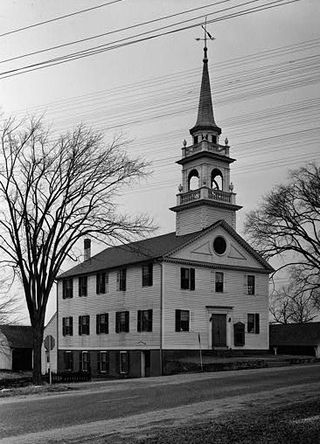
Preston City is a village and the original town center of the town of Preston, Connecticut, United States. The core of the village around the junction of Old Northwest Road and Route 164 is designated as the Preston City Historic District, a historic district that is listed on the National Register of Historic Places. The district is located along Old Shetucket and Amos Roads, which, prior to the 1930s, were major thoroughfares.
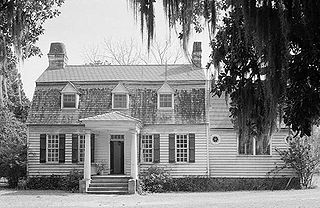
The Oakland Plantation House which is also known as Youghall or Youghal Plantation House, was built about 1750 in Charleston County, South Carolina about 7 mi (11 km) east of Mount Pleasant. It is located about 1 mile (1.6 km) south of U.S. Route 17 on Stratton Place. It was named to the National Register of Historic Places on July 13, 1977.
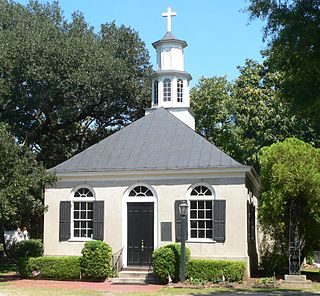
Christ Episcopal Church is a church located in Mount Pleasant, South Carolina.

Charleston Navy Yard Officers' Quarters Historic District is a national historic district located at the former Charleston Naval Shipyard in North Charleston, South Carolina. It encompasses 24 contributing buildings, 2 contributing sites, 1 contributing structure, and 1 contributing object. The site represents development of the upper echelon of senior military housing, support structures, sports facilities and recreational landscape features from 1901 through 1945. The buildings reflect late Victorian and early-20th century eclectic designs including the Italianate, Neo-Classical, Italian Renaissance Revival, Colonial Revival, and the Works Progress Administration (WPA) designed Panama House style.
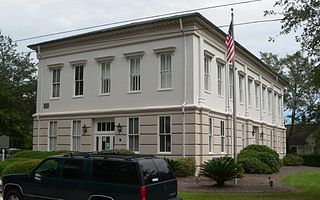
Old Berkeley County Courthouse, also known as Old Courthouse, is a historic courthouse located at Mount Pleasant, Charleston County, South Carolina. It was built in 1884, and is a two-story, rectangular, stucco over brick building in the Italianate style. It features large matching double stairways leading to the main entrance on the second floor. The building served as county courthouse for Berkeley County from 1884 to 1898. After 1898 until 1968, it was used by both Baptists and Lutherans as a church. It is now known as the G. Mcgrath Darby Building.
Fort Palmetto is a historic artillery battery located at Christ Church Parish, Hamlin Sound, Charleston County, South Carolina. It was built in late 1861, and was at the easternmost end of the Christ Church Parish line of defense. At the end of the war this battery mounted one nine-inch gun and two rifled thirty-two pounders. The earthen redoubt measures approximately 160 feet long and 80 feet wide. It has a 15 foot high parapet wall and a powder magazine about 25 feet in height.

Rockville Historic District is a national historic district located at Rockville, Charleston County, South Carolina. The district encompasses 19 contributing buildings in the town of Rockville. The dwellings reflect Rockville's historic role as a summer resort town. The houses are characterized by spacious porches, raised foundations, and large central hallways designed for summer comfort and relaxation. Located in the district are the Grace Episcopal Church and Wadmalaw Presbyterian Church.

Secessionville Historic District is a national historic district located near Folly Beach, Charleston County, South Carolina. It extends into the city of Charleston, South Carolina. The district encompasses six contributing buildings, one contributing site, and one contributing site in Secessionville. The district includes the summer homes of several leading James Island planters, the site of the American Civil War Battle of Secessionville, the unmarked grave of over 300 Union soldiers, and the remains of Fort Lamar, constructed about 1862.

Mount Pleasant Historic District is a national historic district located at Mount Pleasant, Cabarrus County, North Carolina. The district encompasses 98 contributing buildings and 3 contributing structures in the town of Mount Pleasant. It includes residential, institutional, and commercial buildings in a variety of popular architectural styles including Victorian, Colonial Revival, and Bungalow / American Craftsman. Notable buildings include the Jacob Ludwig House, Kindley Mill Village houses, Saint James Evangelical and Reformed Church, Lutheran Church of the Holy Trinity, Mount Pleasant Milling Company, Kindley Cotton Mill, and Tuscarora Cotton Mill.
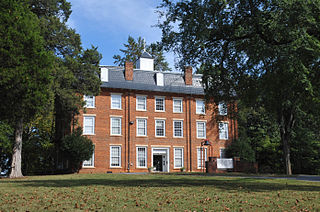
Mount Pleasant Collegiate Institute Historic District is a national historic district located at Mount Pleasant, Cabarrus County, North Carolina. The district encompasses six contributing buildings associated with the Mount Pleasant Collegiate Institute, also known as Western Carolina Male Academy and North Carolina College. They are the three-story brick Main Building (1854-1855); Greek Revival style President's House; Matthias Barrier house; Society Hall; the Boarding House (1868); and the New Building (1925). The Western Carolina Male Academy was established in 1852 by the North Carolina Synod of the Evangelical Lutheran Church of America. The institute closed in 1933 after which, in 1941, the property was put up to auction. The Lentz Hotel was moved inside the district boundaries in 1980.
Mount Vernon Springs Historic District is a national historic district located near Bonlee, Chatham County, North Carolina. The district encompasses 23 contributing buildings, 3 contributing sites, and 7 contributing structures in the rural village of Mount Vernon Springs. The village grew up near a locally famous mineral spring. Notable buildings include the Greek Revival style Female Dormitory of the Baptist Academy (1855), Gothic Revival style Mt. Vernon Springs Presbyterian Church (1885), the John C. Kirkman House, Robert P. Johnson House, and John M. Foust House. Also located in the district are the Mt. Vernon Springs, the Baptist Academy Cemetery, and the Mt. Vernon Springs Presbyterian Church cemetery.
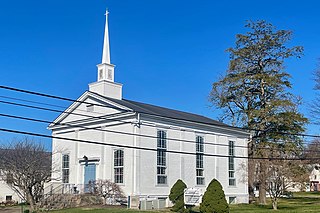
Mount Pleasant is an unincorporated community located along County Route 519 on the border of Alexandria Township and Holland Township, in Hunterdon County, New Jersey. The Mount Pleasant Historic District was listed on the National Register of Historic Places in 1987.





















